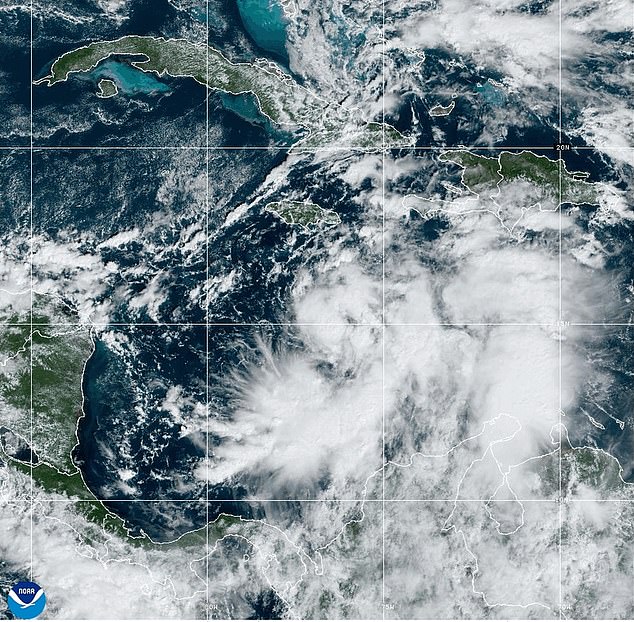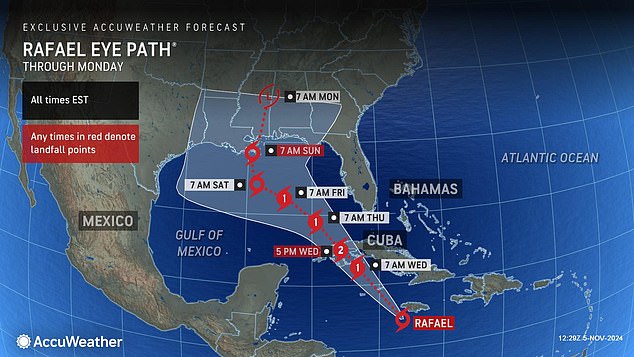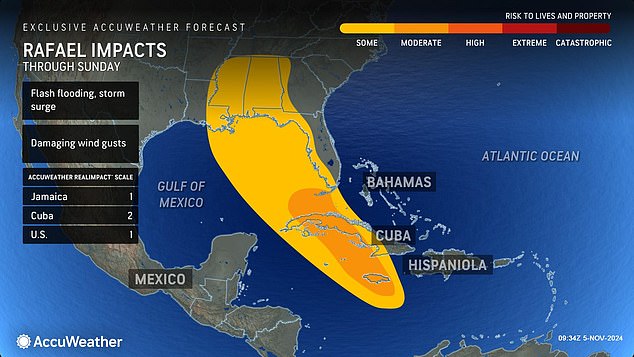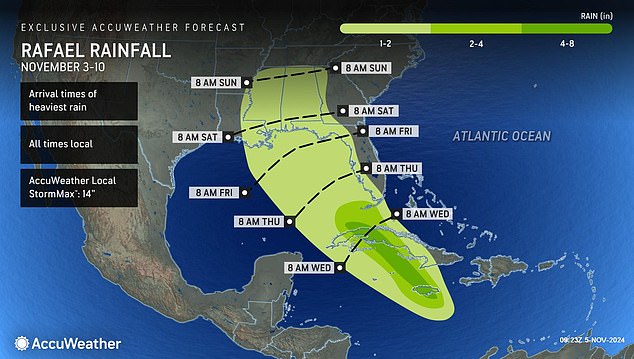‘Life-threatening’ warning issued for Florida as spaghetti model reveals Storm Rafael’s chance of hitting US
A tropical storm warning has been issued for the Florida Keys.
People living in the southwestern part of the sunny state could experience heavy rainfall and flooding on Wednesday due to strengthening Tropical Storm Rafael in the Atlantic Ocean.
Meteorologists have confirmed that Rafael will be upgraded to a Category 2 hurricane when it reaches Cuba on Wednesday, but will weaken to a tropical storm as it heads towards the US late this week.
And now a spaghetti model – so called because the lines resemble strands of pasta – shows the path the storm will take in the coming days.
Rafael will also hit Alabama, Mississippi and Louisiana on Saturday, packing winds of 40 miles per hour, with the storm possibly reaching as far north as Tennessee.
The National Hurricane Center (NHC) warned that water levels in the Keys could rise 5 to 21 feet, causing “life-threatening surf and current conditions.”
These conditions will last approximately six to seven hours and bring two to four inches of rain with wind gusts of 40 to 60 miles per hour.
Brett Anderson, senior meteorologist at AccuWeather, told DailyMail.com they expect “stormy conditions” over the Florida Keys.
He added that the region could see a tornado over parts of Florida’s west coast, but clarified that this will not be like previous hurricanes that have recently made landfall.
A spaghetti model has revealed the expected path of Tropical Storm Rafael. The storm’s impact is likely to extend 105 miles (170 kilometers) from the center and hit the Florida Keys on Wednesday

At 7 a.m. ET, Rafael was 80 miles (130 kilometers) southwest of Jamaica’s Montego Bay and moving northwest at 13 miles (21 kilometers) per hour, with winds up to 37 miles (60 kilometers) per hour.
At 7 a.m. ET, Rafael was 80 miles southwest of Montego Bay, Jamaica, moving northwest at 13 miles per hour, with winds up to 60 miles per hour.
The spaghetti model shows that Rafael will pass through the Cayman Islands, Cuba and Jamaica before heading towards Florida.
The NHC has one public advice This shows on Tuesday that Tropical Storm Rafael will steadily intensify, with wind speeds extending up to 105 miles (170 kilometers) outward from the center of the storm.
Once wind speeds reach 74 miles per hour, Rafael will be promoted to a hurricane.
“The combination of storm surge and tides will cause normally dry areas near the coast to be inundated by rising water moving inland from the coastline,” the NHC said.
Anderson said they expect the storm to weaken from a hurricane to a tropical storm as it reaches the southeastern coast of Louisiana, adding, “We don’t really expect any major impacts to the United States.”
Residents of the Keys and Marathon will be hardest hit by a “storm surge of one to three feet across Key West,” Anderson said, adding, “So there will certainly be some street flooding.”

Rafael is expected to be updated to a Category 2 hurricane when it reaches Cuba on Wednesday, bringing up to 10 inches of rain in some areas
The spaghetti model, made by Tropical factsshowed that the storm is likely to move northwest from its current location in the tropical Atlantic Ocean.
The computer model was created by combining multiple forecast tracks from different weather models on one map.
And each line, which resembles a strand of spaghetti, represents a forecast of a different weather mode used by NHC.
The storm will reach the southern tip of Florida late Wednesday night, and according to AccuWeather, it will still be a Category 2 hurricane when it moves into the western part of the state at 7 a.m. ET on Thursday.
The storm will move through the Gulf of Mexico through Saturday and is expected to be downgraded to a tropical storm by 7 a.m. ET Saturday as it approaches Louisiana, Mississippi and Alabama.
The storm will continue toward Tennessee over the weekend and fade out early Monday morning.

States such as Florida, Louisiana, Mississippi and Alabama are likely to be affected by the storm

The southernmost states are expected to experience up to two inches of rain and high tides of one to two feet
Meteorologist Nicolette Nolan told it CBS: ‘The Gulf coasts of Texas, Louisiana, Mississippi, Alabama and Florida should be alert for consequences by the end of this week.’
Forecasters remain unsure whether the storm’s intensity will remain the same when it reaches Florida later this week, but said it could cause localized wind damage and flash flooding in some areas.
“The system is forecast to enter the western Gulf of Mexico later this week, but given significant uncertainties in the long-term forecast track and intensity, it is too early to determine what, if any, impacts could occur,” the NHC said. Monday.
However, the agency reported that Cuba and the Cayman Islands will be hardest hit, with rainfall reaching up to 25 centimeters in some areas, leading to flash floods and mudslides.
This is the 18th storm to form in the Atlantic Ocean this year, reflecting the National Oceanic and Atmospheric Administration’s (NOAA) forecast that 2024 would be an above-average hurricane season.
November marks the last month of hurricane season, but three more storms could form before the end.
